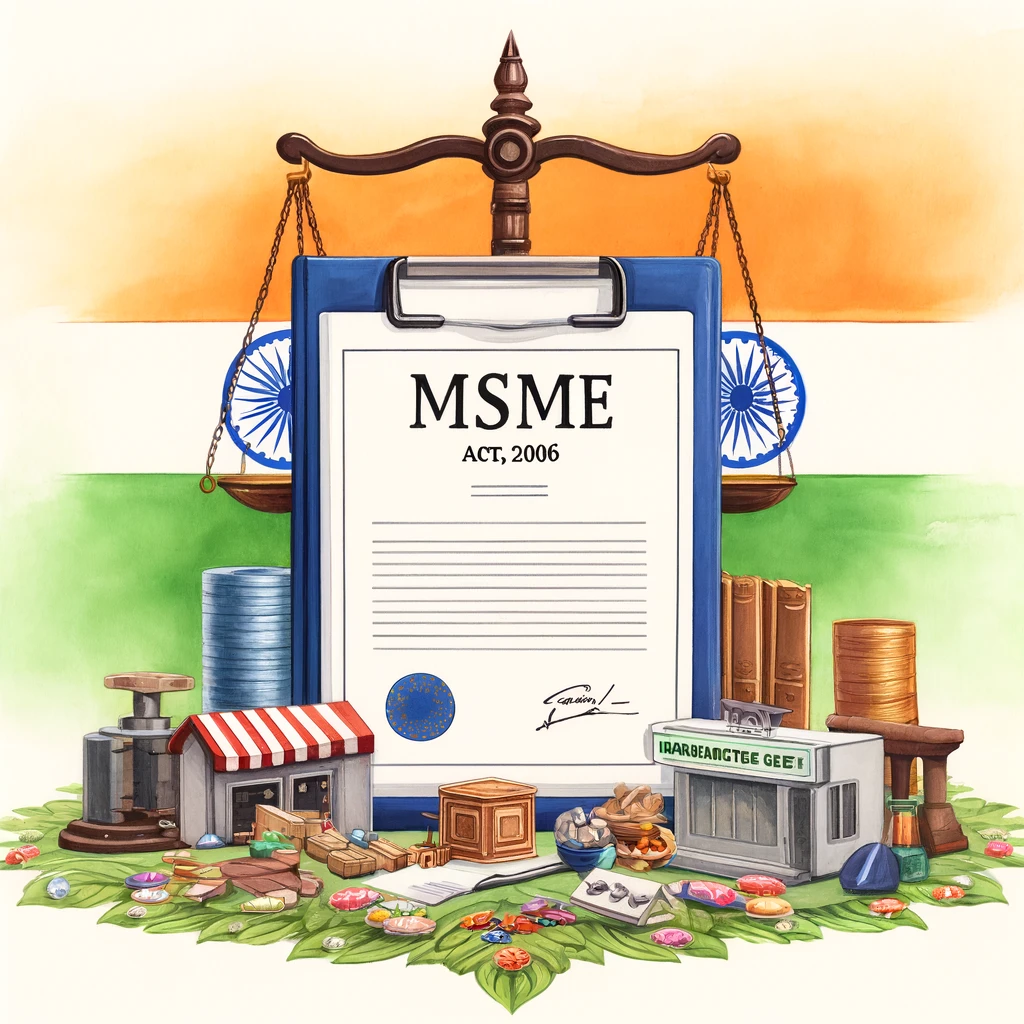SMEs are largely drivers of growth, innovation, and creating jobs. These small and medium enterprises are the backbone of the nation’s economy, as a result, adding value to the country’s GDP and export markets; very much responsible for regional and economic growth, thereby reducing disparities.
- Around 30% of India’s GDP and nearly 45% exports come from SMEs.
- They employ more than 110 million people in urban and rural areas.
- SMEs in India cover widely spread sectors like manufacturing, services, agriculture, and retail.
- In the wake of government initiatives like MSME schemes and Make in India, SMEs are often availed with means of funding, support infrastructures, as well as growth possibilities.
Importance of SMEs in the Indian Economy
Small and Medium Enterprises (SMEs) are a critical component of the Indian economy, often referred to as the backbone of industrial development. They play a significant role in economic growth, employment generation, and innovation. As of 2020, there are approximately 63 million SMEs in India, contributing around 30% to the country’s GDP and employing over 110 million people.
Key Contributions of SMEs
SMEs in India significantly contribute to economic growth by generating employment, driving innovation, and boosting exports, while supporting regional development and enhancing the country’s industrial and service sectors.
Employment Generation
SMEs are the largest employers in India, providing jobs to a substantial portion of the population. They offer employment opportunities across urban and rural areas, helping to reduce regional disparities and promote inclusive growth. The sector is known for its labor-intensive nature, contributing significantly to job creation.
Innovation and Entrepreneurship
SMEs are crucial for fostering innovation and entrepreneurship. They are more flexible and adaptable compared to large enterprises, allowing them to innovate and respond quickly to market changes. Many SMEs operate in niche markets, developing unique products and services that contribute to the diversity and dynamism of the economy.
Exports
SMEs contribute significantly to India’s export earnings. They account for about 45% of the total exports, particularly in sectors like textiles, garments, leather products, and engineering goods. Their ability to cater to international markets with quality products has made them important players in the global supply chain.

Major Challenges Faced by SMEs
SMEs in India face challenges like limited access to finance, inadequate infrastructure, regulatory hurdles, and competition from larger firms, impacting their growth and sustainability in an increasingly competitive market. Despite their importance, SMEs in India face several challenges that hinder their growth and sustainability:
Access to Finance
One of the most significant challenges for SMEs is accessing adequate and timely finance. Banks and financial institutions often consider SMEs high-risk due to their smaller scale and limited credit history. According to the International Finance Corporation (IFC), the credit gap for Indian SMEs is estimated at $230 billion.
Regulatory Issues
SMEs often struggle with complex and cumbersome regulatory requirements. Compliance with various laws, obtaining licenses, and dealing with bureaucratic red tape can be overwhelming for small businesses, diverting their focus from core business activities.
Technology and Innovation
Many SMEs lack access to advanced technology and innovative practices, limiting their competitiveness. The cost of adopting new technologies and a lack of awareness about technological advancements further exacerbate this issue.
Market Access
Reaching new markets, both domestic and international, is a challenge for SMEs. Limited marketing capabilities, inadequate market information, and stiff competition from larger firms often restrict their market penetration.
Infrastructure Deficiencies
Inadequate infrastructure, such as poor transportation, unreliable power supply, and lack of industrial facilities, hampers the operational efficiency of SMEs. These deficiencies increase costs and reduce the competitiveness of small businesses.

Government Policies and Schemes to Support SMEs
The Indian government has introduced several policies and schemes to support the growth and development of it:
MSME Act, 2006
The Micro, Small and Medium Enterprises Development (MSMED) Act, 2006, provides the legal framework for recognizing and regulating SMEs. It categorizes enterprises based on their investment in plant and machinery or equipment.
The Micro, Small, and Medium Enterprises (MSME) Development Act of 2006 in India was enacted to address issues affecting MSMEs, promote their growth, and enhance their competitiveness. The Act provides a legal framework for recognition of the sector, facilitates its development, and boosts its competitiveness through various schemes and incentives. It defines the size of the enterprises based on investment in plant and machinery for manufacturing units or equipment for service sectors.
Prime Minister’s Employment Generation Programme (PMEGP)
PMEGP aims to generate employment opportunities through the establishment of micro-enterprises in rural and urban areas. It provides financial assistance to individuals and groups to set up new ventures.
Credit Guarantee Fund Scheme for Micro and Small Enterprises (CGTMSE)
CGTMSE provides collateral-free credit to micro and small enterprises, encouraging banks to lend more to the sector. The scheme aims to enhance the creditworthiness of SMEs and facilitate easier access to finance.
Technology Upgradation Fund Scheme (TUFS)
TUFS supports the modernization and technological upgradation of SMEs, particularly in the textile sector. It provides financial assistance for acquiring new machinery and technology to improve productivity and competitiveness.
Make in India and Startup India
These initiatives promote innovation, entrepreneurship, and manufacturing. They provide a conducive environment for it to thrive, with benefits like tax exemptions, easier compliance norms, and support for incubation and acceleration.
Case Studies of Successful SMEs
It seriously confront extreme constraints regarding the availability of access to finance, infrastructure facilities, regulatory hurdles, and competitiveness compared with larger firms, which ultimately hampers their growth and sustainability in a highly competitive market.
Amul
Amul, a dairy cooperative, is a classic example of an SME that transformed into a global brand. Starting in 1946 with a small group of farmers, Amul introduced innovative practices in dairy farming and marketing. Its success can be attributed to:
- Strong cooperative structure.
- Continuous innovation in product development.
- Effective marketing strategies.
Zoho Corporation
Zoho Corporation, a software development company, started as a small business and has grown into a global player in the tech industry. Key factors contributing to its success include:
- Focus on innovation and R&D.
- Diverse product portfolio catering to global markets.
- Employee-centric culture promoting creativity and productivity.
Jaipur Rugs
Jaipur Rugs, a hand-knotted rug manufacturing company, has successfully integrated traditional craftsmanship with modern business practices. Its growth is driven by:
- Empowerment of rural artisans.
- Strong focus on quality and design.
- Effective use of e-commerce to reach global markets.

Conclusion
SMEs are vital for India’s economic development, driving growth, employment, and innovation. While they face significant challenges, targeted government policies and support schemes have provided much-needed assistance. The success of companies like Amul, Zoho, and Jaipur Rugs demonstrates the potential of it to scale and compete globally. With continued support and strategic interventions, it can further enhance their contributions to the economy and play a pivotal role in India’s growth story.
| SMEs in India UPSC Notes |
| 1. SMEs in India contribute around 30% to the country’s GDP and play a key role in job creation, employing over 110 million people. 2. SMEs account for approximately 45% of India’s total manufacturing output, significantly driving industrial growth and innovation. 3. Access to finance remains a critical challenge for SMEs, with many facing difficulties in obtaining formal credit from financial institutions. 4. Digital transformation is essential for SMEs to remain competitive, especially in the global market, but digital adoption remains low among small enterprises. 5. Government schemes like the Credit Guarantee Fund Scheme and Pradhan Mantri MUDRA Yojana aim to provide financial support to SMEs for expansion. 6. The informal nature of many SMEs hinders their ability to scale and benefit from government initiatives designed to promote growth and formalization. 7. SMEs are crucial to export growth, contributing around 40% of India’s total exports, highlighting their importance in global trade. 8. Enhancing skill development and technological adoption in SMEs is key to improving productivity and ensuring sustainable economic growth. |



